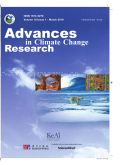- 钛学术文献服务平台 \
- 学术期刊 \
- 基础科学期刊 \
- 天文学、地球科学期刊 \
- 气候变化研究进展(英文版)期刊 \
基本信息来源于合作网站,原文需代理用户跳转至来源网站获取
摘要:
In order to understand impacts of global warming on dust aerosol over East Asia, a regional climate model(RegCM3) coupled with a dust model is employed to simulate the present(1991-2000, following the observed concentration of the greenhouse gases) and future(2091-2100,following the A1B scenario) dust aerosol. Three experiments are performed over East Asia at a horizontal resolution of 50 km, driven by the outputs from a global model of the Model for Interdisciplinary Research on Climate(MIROC3.2_hires), two without(Exp.1 for the present and Exp.2 for the future) and one with(Exp.3 for the future) the radiative effects of dust aerosols. Effects of climate changes on dust aerosols and the feedback of radiative effects in the future are investigated by comparing differences of Exp.2 and Exp.1, Exp.3 and Exp.2, respectively. Results show that global warming will lead to the increases of dust emissions and column burden by 2% and 14% over East Asia, characterized by the increase in December-January-February-March(DJFM) and the decrease in Aprile May(AM). Similar variations are also seen in the projected frequencies of high dust emission events, showing an advanced active season of dust in the future. The net top-of-atmosphere(TOA)radiative forcing is positive over the desert source regions and negative over downwind regions, while the surface radiative forcing is negative over the domain, which will lead to a reduction of dust emissions and column burden.

推荐文章
期刊_丙丁烷TDLAS测量系统的吸收峰自动检测
带间级联激光器
调谐半导体激光吸收光谱
雾剂检漏 中红外吸收峰 洛伦兹光谱线型
不同盐度、温度及光照对漂浮浒苔生理生态的影响
浒苔
盐度
温度
光照
生理生态
期刊_联合空间信息的改进低秩稀疏矩阵分解的高光谱异常目标检测
高光谱图像
异常目标检测 低秩稀疏矩阵分解 稀疏矩阵 残差矩阵
内容分析
关键词云
关键词热度
相关文献总数
(/次)
(/年)
文献信息
| 篇名 | |||
| 来源期刊 | 气候变化研究进展(英文版) | 学科 | 地球科学 |
| 关键词 | |||
| 年,卷(期) | 2016,(3) | 所属期刊栏目 | Special |
| 研究方向 | 页码范围 | ||
| 页数 | 1页 | 分类号 | X513|P467 |
| 字数 | 语种 | 中文 | |
| DOI | |||
五维指标
引文网络
引文网络
二级参考文献 (81)
共引文献 (414)
参考文献 (21)
节点文献
引证文献 (0)
同被引文献 (0)
二级引证文献 (0)
1972(1)
- 参考文献(0)
- 二级参考文献(1)
1980(1)
- 参考文献(0)
- 二级参考文献(1)
1981(1)
- 参考文献(0)
- 二级参考文献(1)
1982(1)
- 参考文献(0)
- 二级参考文献(1)
1984(3)
- 参考文献(0)
- 二级参考文献(3)
1986(3)
- 参考文献(1)
- 二级参考文献(2)
1988(1)
- 参考文献(1)
- 二级参考文献(0)
1989(1)
- 参考文献(1)
- 二级参考文献(0)
1990(1)
- 参考文献(1)
- 二级参考文献(0)
1991(2)
- 参考文献(0)
- 二级参考文献(2)
1992(2)
- 参考文献(0)
- 二级参考文献(2)
1993(1)
- 参考文献(1)
- 二级参考文献(0)
1994(1)
- 参考文献(0)
- 二级参考文献(1)
1995(1)
- 参考文献(0)
- 二级参考文献(1)
1996(2)
- 参考文献(0)
- 二级参考文献(2)
1997(4)
- 参考文献(1)
- 二级参考文献(3)
1998(5)
- 参考文献(1)
- 二级参考文献(4)
1999(1)
- 参考文献(0)
- 二级参考文献(1)
2000(7)
- 参考文献(1)
- 二级参考文献(6)
2001(7)
- 参考文献(1)
- 二级参考文献(6)
2002(8)
- 参考文献(0)
- 二级参考文献(8)
2003(10)
- 参考文献(3)
- 二级参考文献(7)
2004(7)
- 参考文献(1)
- 二级参考文献(6)
2005(4)
- 参考文献(0)
- 二级参考文献(4)
2006(6)
- 参考文献(2)
- 二级参考文献(4)
2007(6)
- 参考文献(2)
- 二级参考文献(4)
2008(8)
- 参考文献(1)
- 二级参考文献(7)
2009(4)
- 参考文献(1)
- 二级参考文献(3)
2010(2)
- 参考文献(1)
- 二级参考文献(1)
2016(1)
- 参考文献(1)
- 二级参考文献(0)
2016(1)
- 参考文献(1)
- 二级参考文献(0)
- 引证文献(0)
- 二级引证文献(0)
引文网络交叉学科
相关学者/机构
期刊影响力
气候变化研究进展(英文版)
主办单位:
国家气候中心
出版周期:
季刊
ISSN:
1674-9278
CN:
11-5918/ P
开本:
16开
出版地:
北京市中关村南大街46号国家气候中心
邮发代号:
创刊时间:
2010
语种:
eng
出版文献量(篇)
377
总下载数(次)
0
总被引数(次)
708
期刊文献
相关文献
推荐文献
- 期刊分类
- 期刊(年)
- 期刊(期)
- 期刊推荐
力学
化学
地球物理学
地质学
基础科学综合
大学学报
天文学
天文学、地球科学
数学
气象学
海洋学
物理学
生物学
生物科学
自然地理学和测绘学
自然科学总论
自然科学理论与方法
资源科学
非线性科学与系统科学
气候变化研究进展(英文版)2022
气候变化研究进展(英文版)2021
气候变化研究进展(英文版)2020
气候变化研究进展(英文版)2019
气候变化研究进展(英文版)2018
气候变化研究进展(英文版)2017
气候变化研究进展(英文版)2016
气候变化研究进展(英文版)2015
气候变化研究进展(英文版)2014
气候变化研究进展(英文版)2013
气候变化研究进展(英文版)2012
气候变化研究进展(英文版)2011
气候变化研究进展(英文版)2010

 免费查重
免费查重










